Travel diaries - Markha valley trek (last bit) in Melbourne Diaries
- Feb. 10, 2014, 10:51 p.m.
- |
- Public
We wake up at early morning, and it’s immediately clear that the weather is taking a turn for the worse, with low, threatening clouds building up in the distance. This next leg, moreover, is supposedly the ‘difficult one’, a steady seven hour climb through the uninhabited Langtang Chan valleys up to a camp at Tikyu. The river level has also increased overnight, making the regular crossings more hazardous than usual. On a day like this I am in my full hiker regalia – trekking poles, specialist pants, waterproof covers, glove covers, thick beanie, as well as a japara that promptly falls apart into bright yellow threads at the first downpour.
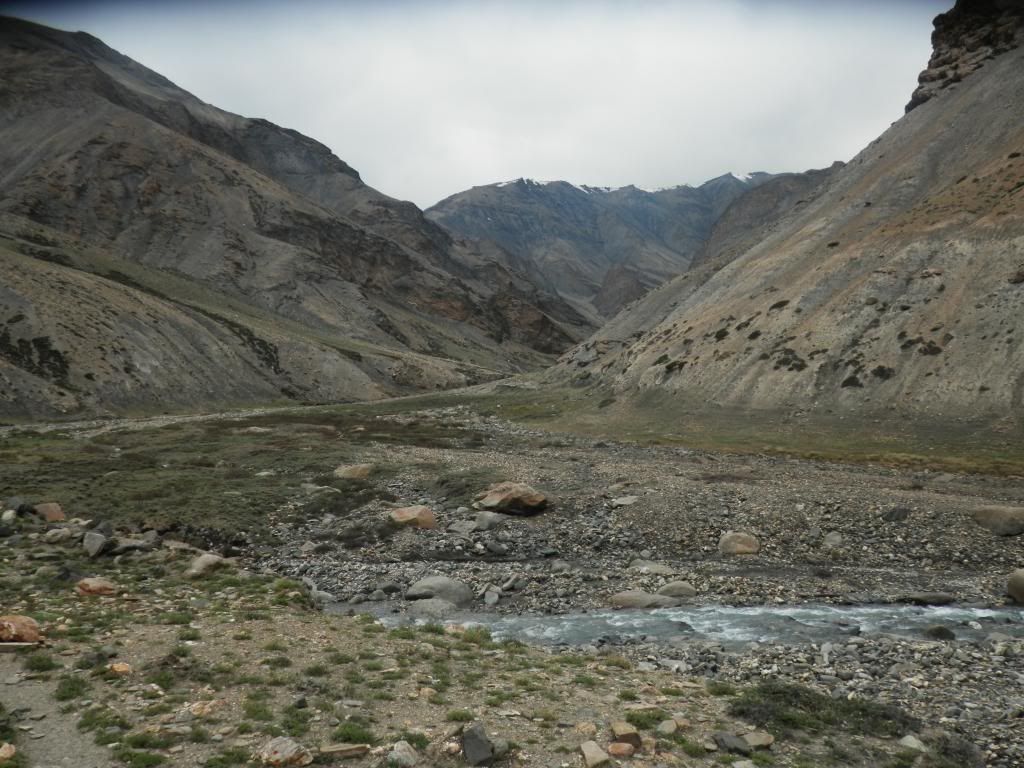
Gloomy path through Langtang Chan valley
Throughout the morning, there is only intermittent rain, and I am repeatedly extracting my wet weather gear from the backpack only to repack it again half an hour later. The scenery, now that we are in more mountainous and rugged territory, is more beautiful than ever, but I’m reluctant to potentially ruin my camera by taking too many photos in these conditions. The animal life is non-existent within these bleak environs – even the chukas appear to have fled.
The rest of the group is led by the guide Garry, and after a long wait with Lopsang for their arrival they are spotted on the horizon on the other side of a very fast flowing river. At the same time as they appear it starts raining very heavily, and Lopsang, who stupidly is wearing little wet weather gear, is now shaking with cold. I’ve been stuck in heavy rain when hiking in Australia and know from trial and error that when there is a risk of hypothermia and no shelter (not even one tree) is in sight, the best thing to do is to keep your body’s circulation flowing by moving steadily to wherever it is you can find shelter. The rest of the group, however, seem to retreat into their mental tortoise shells, dithering at the river’s edge, and in a couple of cases refuse to cross at all (John, a hypochondriac Englishman, seems on the point of open revolt). Given Lopsang’s increasing shivering, this foolish delay sends me into a minor tantrum, yelling across the raging river:
“You CANNOT stay where you are! You will freeze in this weather if you stop moving! You have to get across NOW!”
Nothing happens.
“Yes, it’s cold, but there’s no alternative. Cross the fucking river NOW! NOW!”
John starts bellowing about a sore thumb and holds everyone up again. “I don’t CARE. You either fucking well GET A MOVE ON or you’re all going to be fucked!”
I then feel silly, as it’s not my job to guide them by insults. However, I then hear Garry (the real guide with thirty years experience in the Himalayas) shouting exactly the same thing at my Australian compatriots. Finally, they get the hint, John almost being forcibly dragged across, and we trudge through heavy and biting rain several miles back to camp. For once on this trek, I’m tired, and the other guys are looking in terrible. Angela in particular is nearly a hospital case, vomiting repeatedly, and there is a private discussion about arrangements for her should she not be able to go on the final big pass, Zalung Karpo La, the next morning. John repeatedly whinges about every conceivable ache and pain [Ironically, he is the only person in the group who never got ill], and makes ridiculous food and drink demands. He then comments how I have it easier, supposedly because of my lanky build and lighter pack. That’s it, I’ve had enough:
“John, stop it. My pack is the same weight as yours. My leg size makes no difference – have you seen how small marathon runners’ legs are? I feel pain in the same way you do. I’m breathing the same air you are. I’m eating the same things that you are. I’m getting ill in the same way that everybody in this group - apart from you - is getting ill. The only difference is that I’m shutting up about it.”
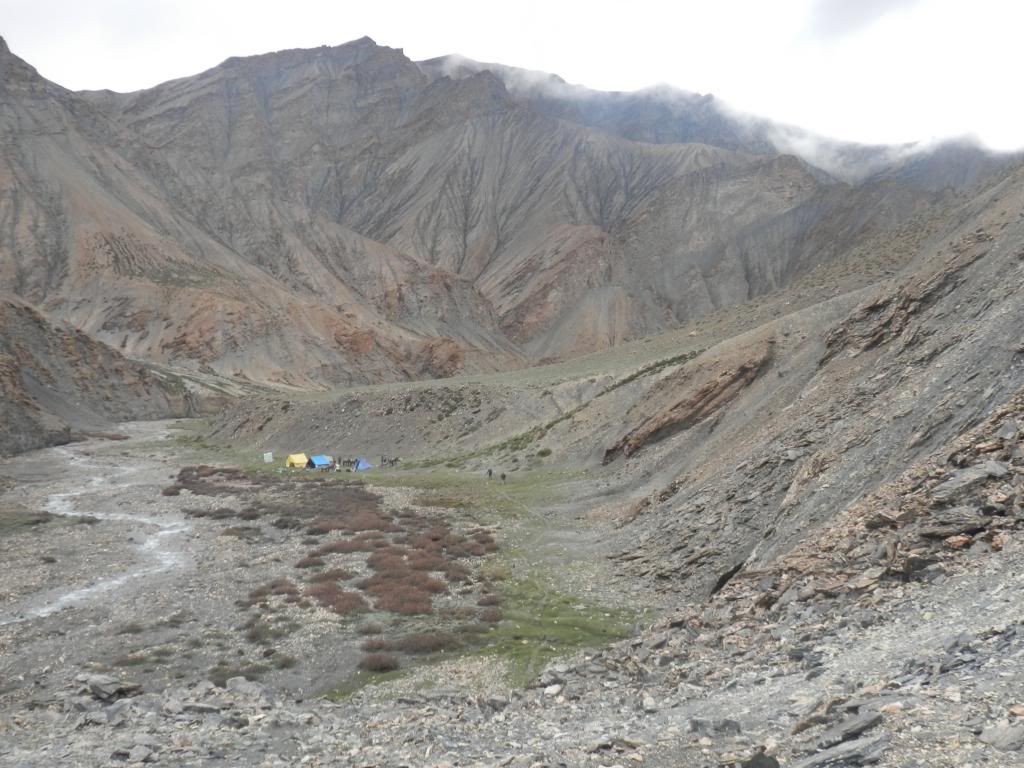
Langtang Chan camp
I leave it at that, as John’s not too bad a person really. Garry, though, can be seen silently smirking. On a full moon, it’s the coldest night yet, and at 4,500m, the thin air makes sleeping difficult. Tonight feels like a mountain expedition rather than the leisurely walk it’s been so far.
The next morning is the last big climb up to the 5,190m pass, the most important part of the trek. Angela, who possesses more mental strength in her little finger than John has in his whole body, has steeled herself for this stage and is up and warming herself even before Garry and I, raring to go despite a long night of puking up outside her tent. I think she overheard talk about her being sent back to the Markha region, and correctly rationalised that in this location it was better to push on forward than head back. It would’ve been a difficult choice in her state, and I’m impressed.
In the thin air, progress is slow. I adopt my usual practice of a heading a mile out from the group (being something of a loner, this is my preference anyway), but the path is difficult to make out in the heavy morning mist and I have to stop several times to wait for a guide. The route is eerily silent, and after an hour I’m at the snowline and an unwelcome scree slope that takes nearly an hour to scramble awkwardly to the top of. From this point on, though, past hikers have left small cairns, and I use these to navigate my way up to the top, stopping every twenty minutes for breath. I’m at 5,000m and air is a limited commodity.
The view at the pass is incredible, stretching from the Kang Yatse peak to the East and then south through the Rupshu valleys, and over various unnamed and unclimbable mountains. By myself for more than an hour beside the cairn and Buddhist prayer flags, I can hear what seems like a snow leopard’s cry screeching in the distance but sadly cannot locate what would be the tourist fluke of a lifetime with my tele-camera (I avoid probable mockery by not mentioning the noise to the group). I feel better than I did at the previous pass, and take the time to be alone with my thoughts, glad that, despite all the discomforts that India presents, I have made it here. In all likelihood, I will never be at a place like this again for the rest of my life.
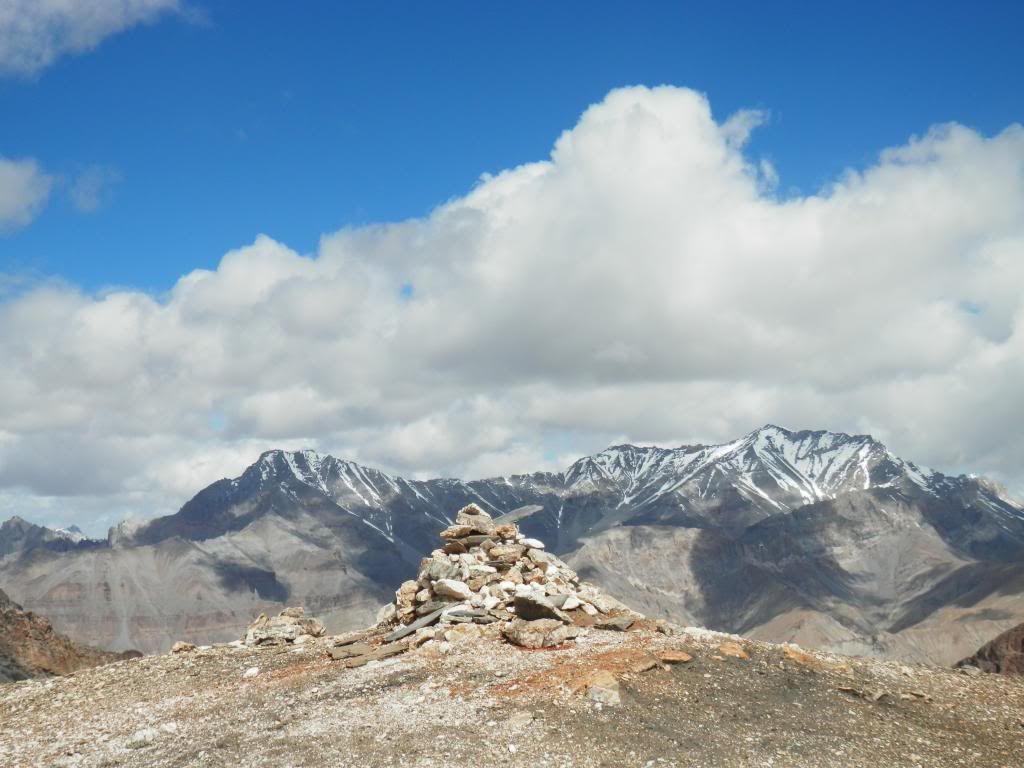
(Lifetime) highest point - 5,190m
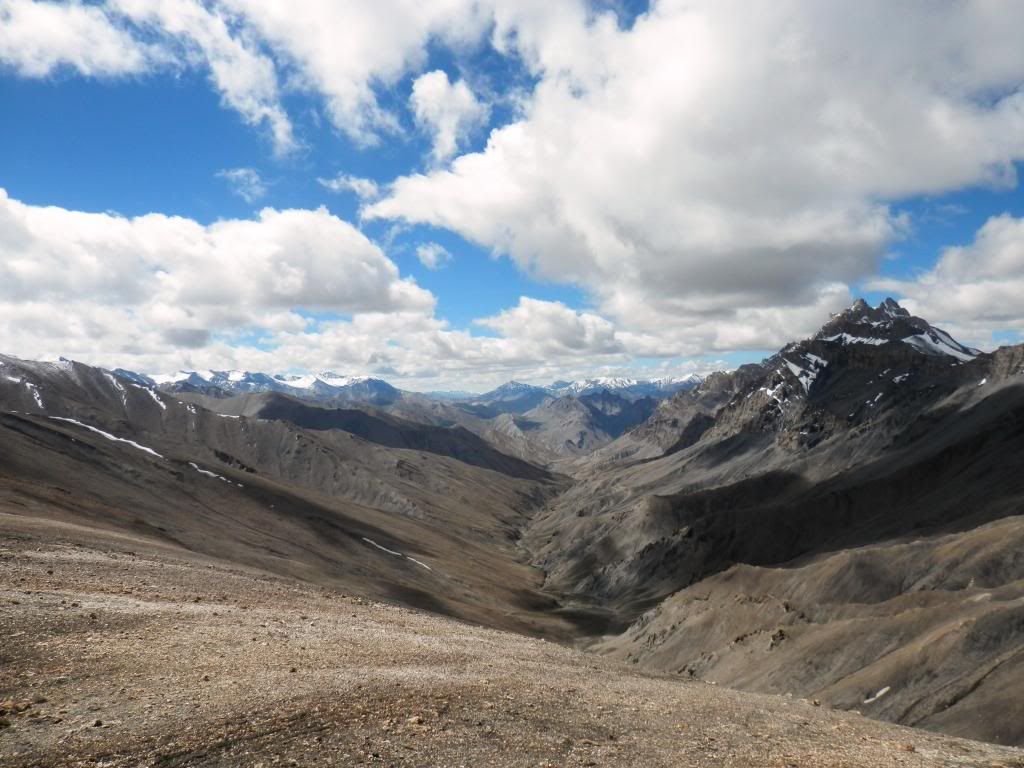
View from Zalung Karpo La

At the top
The rest of the group catch up, and there is a snowball fight at high altitude. The weather has finally cleared, and everybody’s happy to have gotten this far. Angela can be seen scattering her sister’s ashes, an act that explains her determination to get to this point.
The rest of the trek is a slow downhill hop from horse camp to horse camp to the abandoned settlement of Dat. The scenery is spectacular, but no different from what I’ve noted in previous diary entries. I spend most of my time with an impatient Lopsang, who joins another trek after this one, and who queries me relentlessly about Western culture, seeming reassured when I tell him nobody above the age of 15 really likes Justin Bieber or Miley Cyrus (whose faces seem to be presented to Indian teenagers as a western model type). Keeping up with the 19 year old guide is a good workout, especially given his ability to vault along rockfaces that would send me tumbling into an adjacent stream. No other trekkers are sighted, and Lopsang thinks that we are the first to arrive here this trekking season), but there is one surprise visitor. At one point on the last day, I see some marmots fighting, which in the marmot world involves propping yourself on your hind paws and bitch slapping your adversary into submission with your miniscule arms. As I adjust the camera settings for a better look, I feel something furry quickly brush past my left leg. Amazingly, it’s the stray dog Lucy, and my photo ends up being a picture of her savaging one of the poor marmots in her jaws (in the interests of animal lovers, I won’t post this one online). Lucy has over two whole days followed my scent by herself through crappy weather and across the daunting Zalung Karpo La pass. In total, she’d have gone 90k in the last week. She’s looking in poor shape, though, with a matted coat and unexplained cuts to her face.
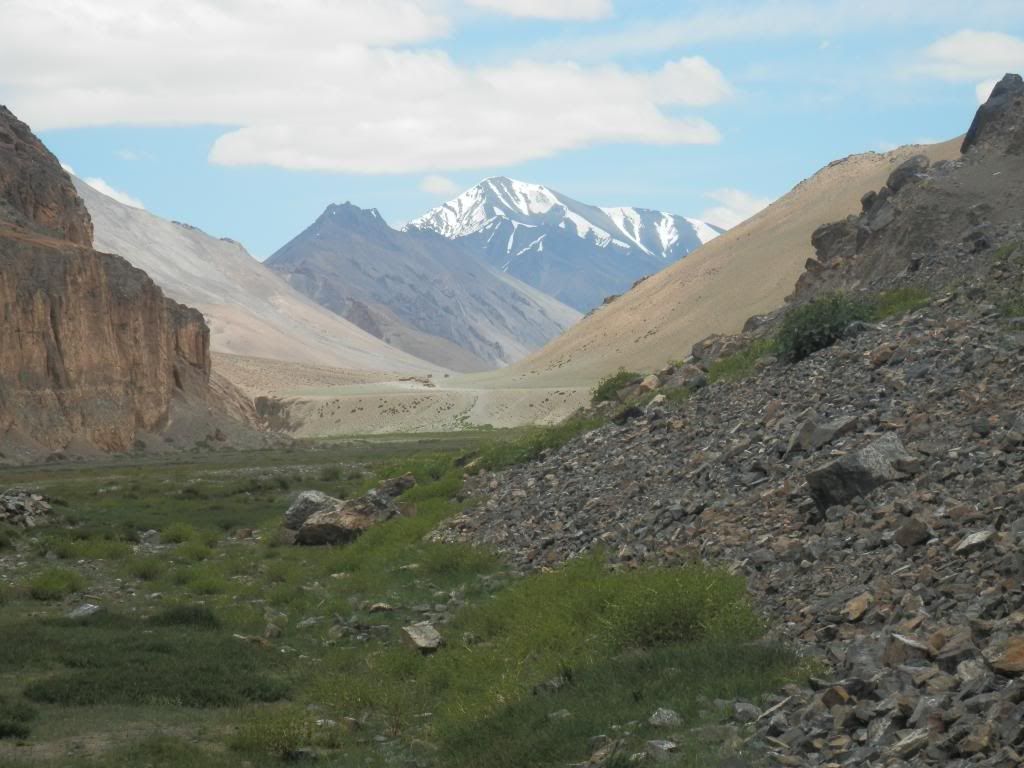
Path to Dat
The end-point of the trek is the empty, boarded houses of Dat, which lie on the edge of a large, bowl-like valley. The horsemen that reside here live elsewhere in the summer months and return in autumn for reasons that aren’t entirely clear to me. After Lopsang, Garry is the first back, and while waiting for the rest to arrive we discuss what his next hiking journey will be. He is disdainful of over-touristed Nepal, pointing to the empty expanse in front of me. “If this were Annapurna, there’d be another camp, there, and there, and there, and there.” Everybody else staggers in over the next two hours. Although some have really struggled in this group, and in truth were not sufficiently fit enough, nobody has had the ultimate indignity of being forced to ride on the donkey named ‘Baby’. I spend my final night of the trek throwing spare food to Lucy and photographing fat marmots, ancestors of the mammals that were supposedly the Patient X for the Black Death. There is another dog at the campsite, which probably followed some horsemen and was then abandoned by them. Consequently, it is a goner, starving beyond revival and barely able to move. That night, I can hear Lucy, who is so gentle around humans, killing it and then tearing into its flesh, a brutal climate hosting a brutal world.

Donkeys at the end of the trek
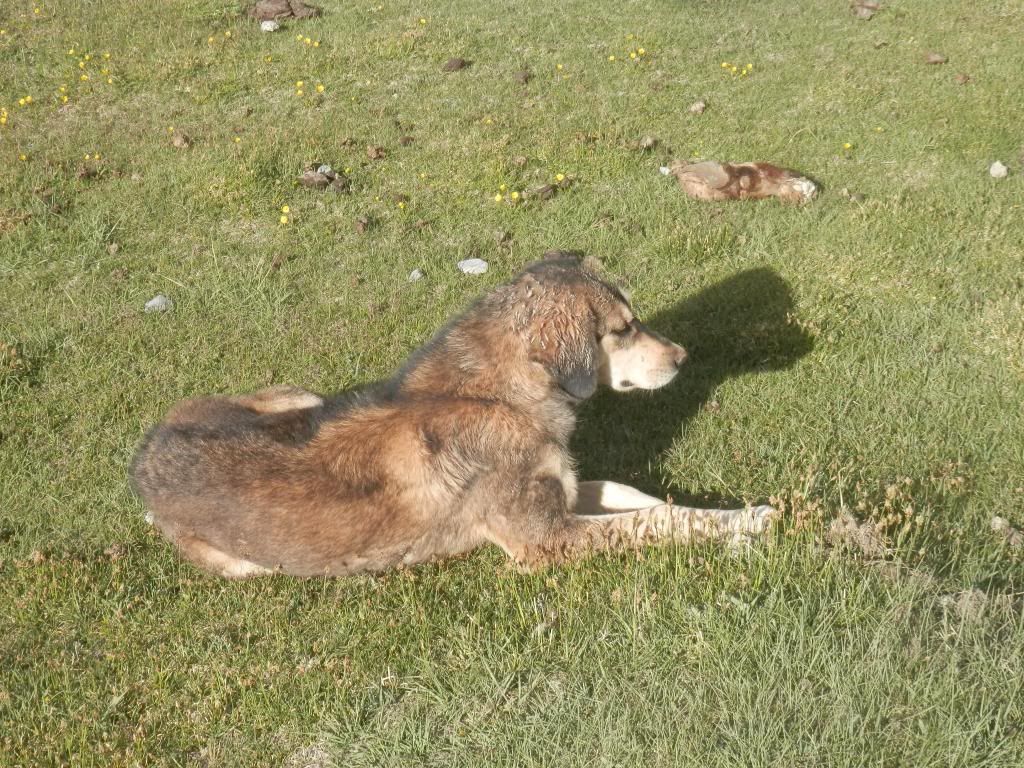
Lucy having a well earned rest
The remainder of the Ladakhi leg of my holiday is by car. There is a side journey to Lake Kar so Bob, who is doing a study on bird-watching, can get long distance footage of a couple of bored black herons sitting in a swampy salt lake. It’s a Sunday, and the impoverished Nepalese and Bihari workers that would otherwise be toiling in the hot, high altitude climate are instead relaxing by Ladakh’s lakes and rivers, getting their hair cut or swimming in the undrinkable Himalayan waters. The night stay is at unnaturally light blue Tso Moriri lake, a stark, brackish body of water with many local Indian tourists in a holiday camp environment. I spend most of the day with Angela and another guide skipping stones across the bouncy Dead Sea-like watertop and watching red robed monks pass by with their packs of donkeys. There is a large, celebratory dinner that night with the remainder of the food, some of which, it soon becomes clear, has gone badly off.
Throughout the night I am violently sick, disgorging the entire contents of my stomach, and then any other bodily liquid my digestive system is capable of evacuating. At 4,400m altitude, this food poisoning triggers some altitude sickness symptoms – great difficulty breathing, slight headaches and non-stop nausea. Thankfully, the trekking part of the journey is over, so what follows is nothing more than an unpleasant eight hour car journey with the rest of the group back to Leh. Every time the car bumps over a 5,000m pass I have to leave the vehicle to be sick on the side of the road. [You can buy baseball caps with ‘I survived the world’s highest road passes’ each time you go across one of these vehicular milestones, but mine would have to say something different.]

Tso Moriri lake
One highlight of Ladakhi roads - other than of course the regular truck breakdowns, pointless vehicle inspections by fat army officers, potholes the size of dinosaur footprints, and having to intermittently vomit in public - are the roadsigns put up by the Border Roads Organisation. Someone in this mundane bureaucratic post is clearly expressing his or her creativity through a series of clumsy safety-themed epigrams greeting motorist:
“After drinking whisky driving is risky.”
“Better late than the late mister.”
“A cat has nine lives but not the one who drives.”
Once Leh is reached, we’re at a comparatively lower altitude, and I recover a bit, glad for the comparative luxury of the Osasima ‘Brad Pitt’ hotel. It is not until the next day that I find out that Australia has a new prime minister, news practically every Australian public servant other than myself would have known two weeks ago. As somebody committed to news updates every hour or every day, it is a weird feeling to be so out of step with current affairs. I spend my last day in Leh revisiting its temples, stupas and narrow, dust swathed alleys, contemplating what, if anything, the changed political circumstances mean for my job, or why I am even thinking about my job in such a landscape as this.
The next morning, there is a delayed flight back to Delhi. As we are still in the state of Kashmir, security restrictions remain tight, and a French hiking couple hold up the queues for a long time by expressing their indignation that they’re not allowed to take trekking poles with them as hand luggage – it’s amazing that in this day and age anybody honestly believes that customs will be okay with you bringing large two metre long iron spikes onto a plane. Delhi is now in the monsoon season, and the flight back is rickety, with large turbulence drops every minute or so. I’m glad at first for the lower altitude and greater amount of air (Ladakhis actually get ‘reverse sickness’ upon leaving their home state as a result of the increased oxygen), but am disappointed to reminded that this is Delhi’s grey, smog-clumped air I’m breathing. I’m still too ill to do any final sightseeing in the city, and content myself instead with the comforts of the deluxe Lalit Grand, watching the sunset fall over a typically cacophonous train station twenty storeys below me, dozens of eagles circling at eye level for the rats scurrying beneath. There is a shock when I measure myself on the bathroom scales – in the space of one month, I have lost 11 kilograms. Heat exposure, lack of air and food poisoning are my new pathway to weight loss.
Last updated August 26, 2014



No comments.